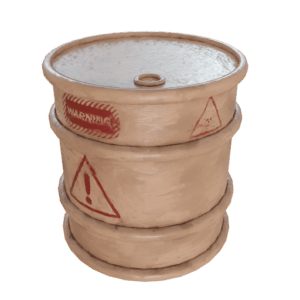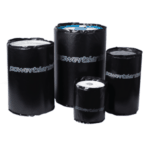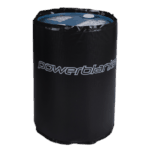Many industries rely on the capacity and durability of 30-gallon drum barrels. Obviously, they can hold up to 30 gallons of liquid material. However, the actual dimensions of 30-gallon drums vary depending on the material the barrel or drum is made of. Read on to learn more.
What are the dimensions of a 30-gallon drum (height, width, length)?
The dimensions of a 30-gallon drum can vary depending on the material used to make the drum and the manufacturer. However, in general, a 30-gallon drum will have the following dimensions:
- Height: 27-29 inches
- Diameter: 18-19 inches
- Length: 29-31 inches
The specified product dimensions of a 30-gallon drum can be found on the manufacturer’s website. These may differ from manufacturer to manufacturer due to the type of material the drum is made of:
- Plastic: 27-29 inches height, 18-19 inches diameter, 29-31 inches length
- Steel: 28-30 inches height, 19-20 inches diameter, 30-32 inches length
- Stainless steel: 29-31 inches height, 19-20 inches diameter, 31-33 inches length
How to measure the dimensions of a drum
To measure a drum’s dimensions most accurately, follow these steps:
- Place the drum on a flat, firm surface.
- Place a tape measure across the opening from one edge to the other to measure the width or diameter.
- Measure the height of the barrel from the base to the top.
- Check the measurements against the manufacturer’s specifications.
When using drum and barrel heaters to keep drums warm, make sure to take into account the added bulk of the heater or drum insulation blanket.
How much weight can a 30-gallon drum hold before it becomes too heavy to move around easily?
The weight capacity of a 30-gallon drum will depend on the material the drum is made from and the type of material it is storing.
- A plastic 30-gallon drum can hold up to 450 pounds of weight.
- A steel 30-gallon drum can hold up to 750 pounds of weight.
- A stainless steel 30-gallon drum can hold up to 1,000 pounds of weight.
The type of material the drum is storing also affects the weight capacity. For example, a drum filled with water will weigh more than a drum filled with air.
Remember: the weight capacity of a 30-gallon drum is the maximum weight that the drum can safely hold. It’s always best to err on the side of caution and not overload a drum.
Here are some handy safety tips for lifting and moving 30-gallon drums:
- Use a hand truck or other lifting device to move the drum.
- Do not lift the drum by the handles alone.
- Keep the drum level when lifting and moving it.
- Be careful not to drop the drum.
- If the drum is filled with hazardous material, wear appropriate personal protective equipment (PPE).
If you have any questions about the weight capacity of a specific 30-gallon drum, always contact the manufacturer.
What type of material is a 30-gallon drum typically made from – plastic or metal?
30-gallon drums can be made from either plastic or metal (usually steel). Plastic drums are typically made from high-density polyethylene (HDPE), which is a durable and lightweight material. Metal drums are typically made from steel or stainless steel, which are strong and corrosion-resistant materials.
The type of material used to make a 30-gallon drum will depend on the intended use of the drum. Plastic drums are often used for storing non-hazardous materials, such as food and household products. Metal drums are often used for storing hazardous materials, such as chemicals and fuels.
Ultimately, the best material for a 30-gallon drum will depend on the specific needs of the user.
Can you use a 30-gallon drum for anything other than storage or transportation, such as mixing concrete or waste disposal purposes?
30-gallon drums can also be used for waste disposal purposes, such as burying waste in a landfill. However, they should not be used to mix concrete as this could potentially damage the drum.
Preventing barrels from freezing
Many manufacturing processes use products straight from the drum. They may pour out using gravity or with a pump. Some products require heating to reduce their viscosity. Others, such as water-based products, must not freeze if stored in areas subject to winter weather.
The solution is 30-gallon drum and barrel heaters and insulation. They maintain a set temperature without overheating the product. Always use a 30-gallon hazardous area drum and tote heater for flammable or explosive products.
If you no longer need your 30-gallon drum, what are the best ways to dispose of it properly so that it doesn’t become an environmental hazard?
There are a few different ways to dispose of a 30-gallon drum properly. The best way will depend on the material the drum is made from and the type of material it was previously storing.
If the drum is made from plastic:
- If the drum was previously storing non-hazardous materials, you can recycle it. Most recycling centers will accept plastic drums.
- If the drum was previously storing hazardous materials, you will need to contact a hazardous waste disposal company. These companies have the proper equipment and training to safely dispose of hazardous waste.
If the drum is made from metal, such as steel or stainless steel:
- If the drum was previously storing non-hazardous materials, you can recycle it. Most recycling centers will accept metal drums.
- If the drum was previously storing hazardous materials, you will need to contact a hazardous waste disposal company. These companies have the proper equipment and training to safely dispose of hazardous waste.
If the drum is still filled with material:
- If the drum is filled with non-hazardous materials, you can empty the drum and then recycle or dispose of the drum as described above.
- If the drum is filled with hazardous materials, you will need to contact a hazardous waste disposal company. These companies have the proper equipment and training to safely dispose of hazardous waste.
For disposing of 30-gallon drums and barrels in general, follow these additional tips:
- Always wear appropriate personal protective equipment (PPE) when handling drums, especially if they are filled with hazardous materials.
- Do not puncture or crush drums, as this could release hazardous materials.
- Label drums clearly with the contents and the date they were last used.
- Contact your local waste management company or hazardous waste disposal company for more information on how to dispose of 30-gallon drums properly.
Not big enough?
Try using a 55-gallon drum or barrel for your storage needs.
Powerblanket's industrial drum & barrel heaters provide even and consistent heating, eliminating waste and lowering costs.







